 |
||
|
||
| ||
Plextor PX-W1210Si and Teac W512SB
We decided to start a cycle of articles devoted to the CD-RW drives with SCSI interface with the latest recorders of this category. I think that the most advanced CD-RW devices will be able to show all their potential, highlights and downsides of the SCSI-interface. We won't consider in details the principle of operating of the interface but we will still speak about whether SCSI recorders have an advantage over their IDE analogs; and if they have, how considerable it is. Some users are scared to buy SCSI-devices since they require a SCSI-controller. And in case it's absent they are to invest into it. But remember that the recorder doesn't need obligatory an expensive Ultra3 SCSI adapter; you may use a simple cheap Ultra SCSI controller, e.g. the Tekram DC-315U. SCSI-recorders cost a little bit more than their IDE analogs. Sometimes the prices are even equal. What, then, gives you a purchase of a SCSI CD-RW drive? The SCSI interface (Small Computer System Interface) was developed in 1979. Initially it was targeted at small computer systems and its specification took around 20 pages. It specified how a PC should interact with peripherals such as scanners, external storage devices, printers etc. The primary attention was paid to operating of the system with a hard disc. SCSI had every chance to reach a status of a prevalent interface of interacting with a disc subsystem and peripherals in the desktop systems. Till recently all Apple Macintosh computers were equipped with SCSI controllers, and this interface was standard for "Mac-systems". But soon a new interface - IDE (Integrated Device Electronics) - appeared in the scene, which provided quite decent characteristics together with low price. But despite obvious merits of the IDE interface (rather high efficiency, low cost and simple connection) it has some downsides as well. First, one IDE channel won't take more than two devices; secondly, two IDE-devices on one channel will hamper each other. Sometimes the high-priority IDE device will take nearly the whole bus. That's why it's no wonder that more advanced SCSI interface took the leading position not on the home PC market but on the server and high-efficiency work station market. Many might remember that such solutions as RAID-arrays were always a privilege of storage devices with SCSI interface, and only recently they started appearing on the base of an IDE bus. The testing strategy of SCSI-drives hasn't changed much as compared with recorders with IDE interface. Some tests disappeared, some were added or altered. First we had to refuse the CD-ROM Drive Analyzer program since it can't work with CD-RW drives with SCSI interface. Additionally to the CDSpeed 99 we chose a program DiskTest 1.6 by Dmitry Shvetsov. The program is intended for fast recursive reading of the whole disc or a separate directory with subdirectories in order to check the readability of the disc, speed estimation etc. Undoubtedly, there are more modern analogs, but we are inclined to think that the DiskTest gives the most correct results. The testbed hasn't changed: the ASUSTeK K7M motherboard with the AMD Athlon 600 MHz processor, 256 MBytes PC100 SDRAM Micron (2x128 MB), IDE-HDD IBM-DPTA-372050 20 GBytes 7200RPM in the PaloAlto 600 case. The recorders were connected to the BusLogic MultiMaster SCSI controller. We used passive terminators, i.e. those that are located on the rear panel of the drive. After installation of the recorders, in the "System properties" in the section "CD reading device" there should be a resolving flag against the item "Synchronous data transfer". For testing, beside the CD-R Philips Silver Premium (1x-16x) we used also the CD-R Mirex Gold (1-12X). But all results concerning disc record speed were obtained with the CD-R Philips Silver Premium.
Test results
CDWinBench 99 CD-ROM Transfer RateFor performance comparison in reading operations we chose (beside CD-ROM TEAC 540E) the IDE-analogs of the considered drives. More detailed information on the TEAC CD-W512EB recorder will be published a bit later.  All CD-RW models have shown practically the same performance level (and the recorders of the same manufacturer and from the same series - exactly the same results). At the same time, the result for inside data transfer rate of the CD-ROM TEAC turned to be the best.  The results are unexpected. Looking at the scores you might notice that there is practically no difference in performance between the SCSI and IDE models from TEAC, and the Plextor PX-W1210Si showed higher scores than the PX-W1210TA and so took the lead. The CPU utilization was: 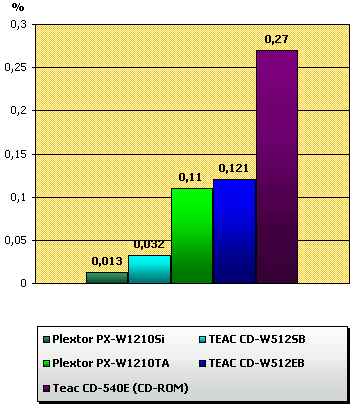 As usual, the TEAC 540E shows the highest percentage of the CPU loading. The IDE recorders' results are practically equal, they load the CPU a bit more than their SCSI counterparts. As it was expected, the TEAC CD-W512SB and the Plextor PlexWriter PX-W1210Si performed the best. But note that the WinBench treated rather strange the SCSI drives: sometimes it showed the negative figures of CPU utilization :), that's why we had to carry out these tests more times for more correct results. CDWinBench 99 CD-ROM Access Time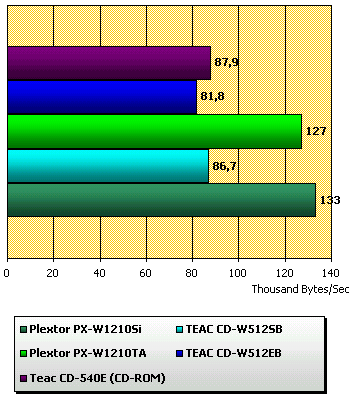 The results are logical: the models of the same manufacturer show practically identical results corresponding to the ratings. Nevertheless, the PlexWriter PX-W1210Si, which had been one of the leaders, here markedly lagged behind even IDE-models. In this test the distinguishing feature is that IDE-models have higher data access speed than the SCSI ones. The margin is insignificant, though. CDWinBench 99 CPU Utilization The scores of all the CD-RW drives are almost identical. But still, the SCSI-recorders performed better, and the TEAC CD-W512SB took first place showing the CPU utilization less than 2%. Time taken for CD recording
Record of the CD-R Philips Silver Premium (12x)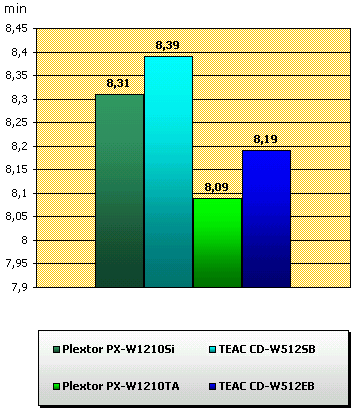 Again, the IDE CD-RW drives work faster. Of course, the 10 second difference is not huge, however, the Plextor recorders writes faster at high speeds. Record of the CD-R Noname (4x)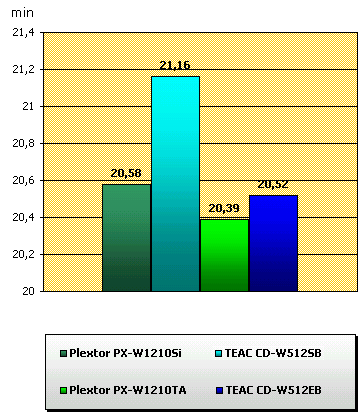 And at lower speeds the IDE-recorders performs better. Comparing the drives with the same interface, we should note that the Plextor is again leads. Time taken for the full formatting of CD-RW disc in UDF format
Philips CD-RW (4x)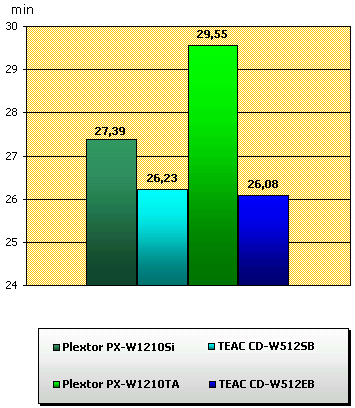 The result shown by the Plextor PX-W1210TA is quite strange. But even disregarding this fact, the TEAC storage devices show higher efficiency when formatting CD-RW disc. Ricoh CD-RW (10x)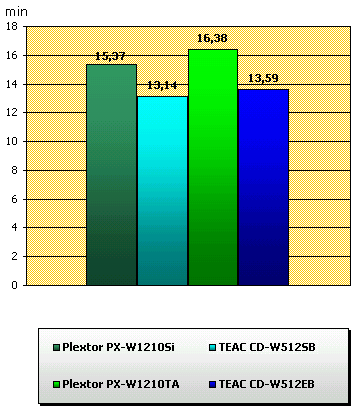 The trend keeps. But for one thing - in this test the SCSI recorder TEAC shot ahead leaving the CD-W512EB almost a minute behind. Record of CD-RW disc (UDF)
Philips CD-RW (4x)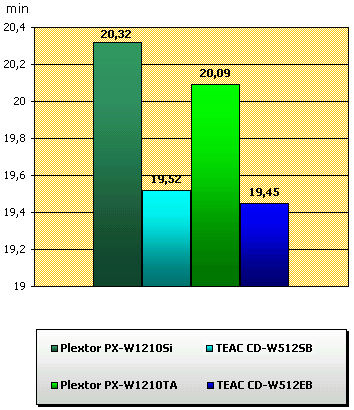 Here, the situation changes: the TEAC drives made higher quality recording than the Plextor, but IDE recorders turned to be faster. CD-RW Ricoh (10x)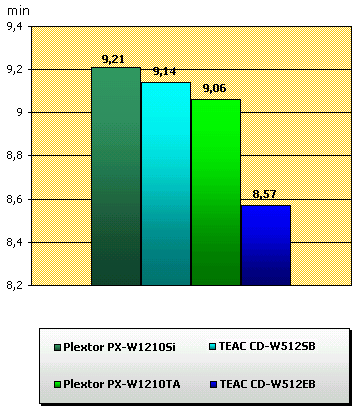 Nothing changed: the TEAC CD-W512EB is the best at recording of the CD-RW both at low and at high speeds, the PX-W1210TA falls a little bit behind. BLER factor for the recorded CD-R Philips Silver Premium (12X write speed)
BLER factor for the recorded CD-R Mirex Gold (12X write speed)
BLER factor for the recorded CD-R "Noname" (4X write speed)
In the documentation on the Teac CD-W512EB is specified that the CD-RW drive is based on the Sanyo transport, therefore we may assume that it's included also in SCSI model. Considering the fact that the Plextor also uses a Sanyo transport the close BLER results of the recorded discs can be explained. CDTest 99For graphs of reading of other drives see the first four, the sixth and the seventh parts of the review devoted to the IDE CD-RW drives. Graphs of reading of the recorded CD-R Philips Silver Premium (12X write speed)
Graphs of reading of the recorded CD-R Mirex Gold (12X write speed)
Graphs of reading of the recorded CD-R "Noname" (4X write speed)
Note that the graphs of the high quality discs are very similar, but for the discs recorded on the Plextor which do not have a small saw on the definite parts. As for the cyanine "noname" ones the TEAC gave out each time a broken graph (we decided to record two more "noname" discs in order to prove the quality of the disc). CD Speed 99 test results of the recorded CD-R Philips Silver Premium
CD Speed 99 test results of the recorded CD-R Mirex Gold
CD Speed 99 test results of the recorded CD-R "Noname"
CD Quality Check test results of the 4x recorded 4X CD-RW (UDF) discs
CD Quality Check test results of the 10X recorded CD-RW (UDF) discs
CD Quality Check test results of the recorded CD-RW (ISO) discs
The TEAC proves again that it operates with CD-RW discs better than the Plextor. We should mark out the improved read speed of the PX-W1210Si compared with the IDE-model. Read speed of the recorded CD-R Philips Silver Premium (CD Quality Check)
Read speed of the recorded CD-R Mirex Gold (CD Quality Check)
Read speed of the recorded CD-R "Noname" (CD Quality Check)
The results for 32X are rather satisfactory. You must remember the results of the 40x Yamaha CRW2100E; then, compare the obtained figures, and 22X read speed wouldn't seem so low. DiskTest test results of the recorded CD-R Philips Silver Premium
DiskTest test results of the recorded CD-R Mirex Gold
DiskTest test results of the recorded CD-R "Noname"
* - max/min ratio Audio track extraction from audio CDs (CDDAE 99)
Piano Favorites
Acoustic Planet vol.2
Bloodhound Gang "Greatest Hits"
* - 7.37% means that the drive extracted 7.37% of the CD with errors. The results of the both drives are similar disregarding a small margin when testing the track extraction speed from the Piano Favorites CD. In general, the speed is very high, and there are sometimes much less errors in the extracted tracks than in the best IDE-recorders. Direct copying from recorded CDs to the hard driveThis test is aimed to obtain more proper information, do not take it as the serious torture for the drive. Since the disc structure is nonuniform and compound, the results were quite low even for 40x devices. Copying of the recorded CD-R Philips Silver Premium Copying of the recorded CD-R Mirex Gold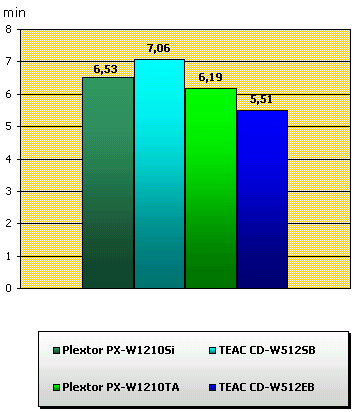 Copying of the recorded CD-R "Noname"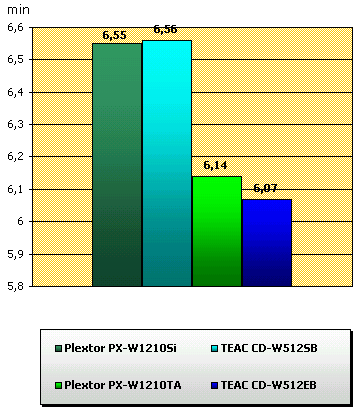 Reading of damaged CDs
"Golden" disc
"Scratched"
"Damaged"
Conclusion and summaryAs showed the testing, we have seen two practically identical CD-RW drives. The both can boast of good speed results, high reading speed of the CD-RW discs, quality recording of the discs, high-speed and correct extraction of the audio tracks. But there arises a question why in some tests the SCSI-devices were slower than the analog IDE ones? There is no a simple answer: all depends on the usable controller, software, OS. But the fact is that with the given computer configuration, with the given software under the control of the Windows 98 the SCSI-drives were slower. For a wider statistics we also tested the recorders with the Tecram DC-315U controller which is one of the most popular solutions for the systems with a SCSI recorder. The results obtained with the BusLogic MultiMaster were not in favor of the Tecram. But speaking about the performance do not forget many shortcomings of IDE devices as compared with the SCSI-devices. They are: inability of the simultaneous work of the IDE-devices, higher CPU utilization in case the IDE-drive doesn't support the DMA mode or realizes this support incorrectly. Besides, note a wide range of application of the SCSI interface. So, what's the conclusion? If you have a SCSI-controller or you may invest into it, if you need the ensured stability and reliability while recording, then, when purchasing a recorder pay a closer attention exactly to the SCSI-drives. After you have defined an interface, you are to decide what speed set it should dispose of. The models in question will give you the maximum possible performance of a system based on the SCSI interface together with high quality. Which one of the considered drives should be given a privilege to? A user must decide whether $40-50 are worth a brandname manufacturer, higher performance and quality of recorded discs.
Test programs:
Write a comment below. No registration needed!
|
Platform · Video · Multimedia · Mobile · Other || About us & Privacy policy · Twitter · Facebook Copyright © Byrds Research & Publishing, Ltd., 1997–2011. All rights reserved. |